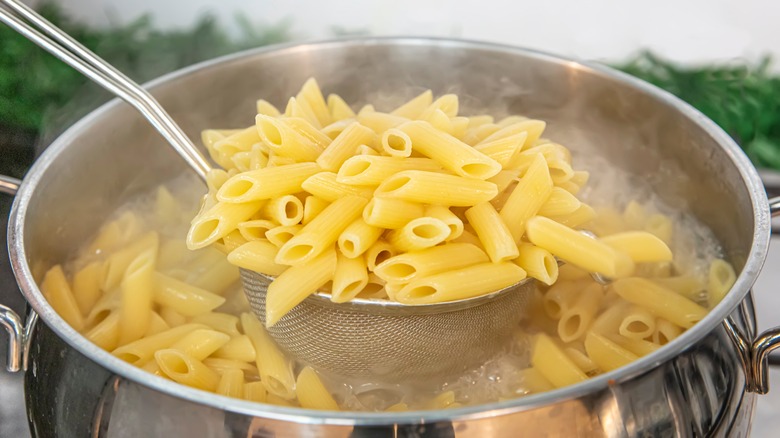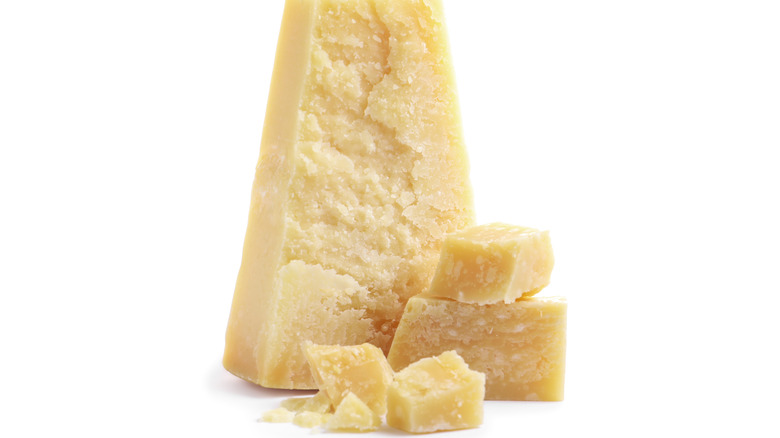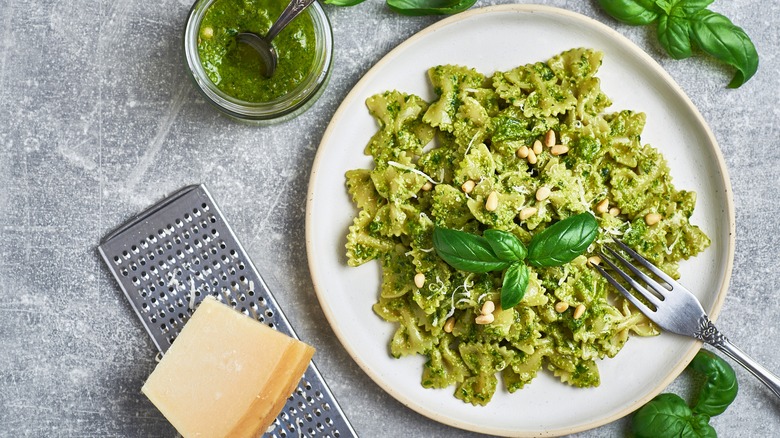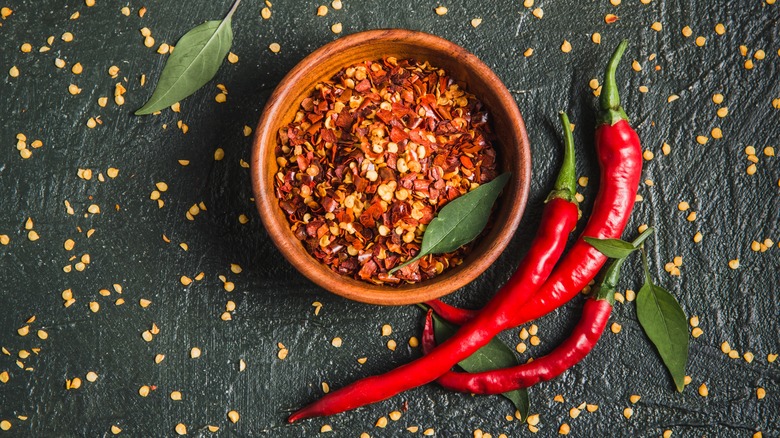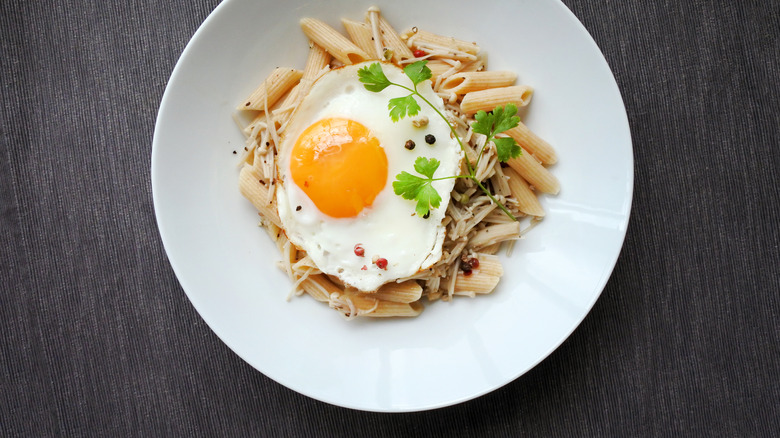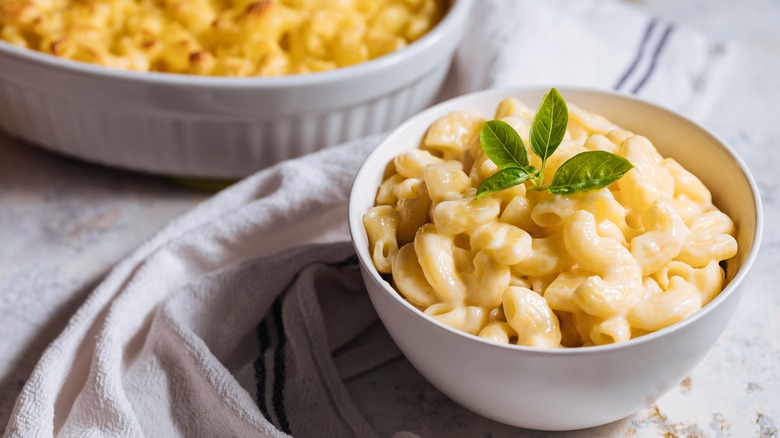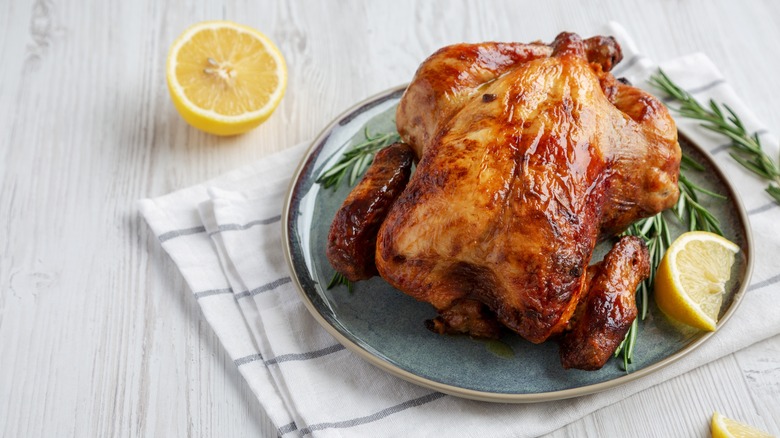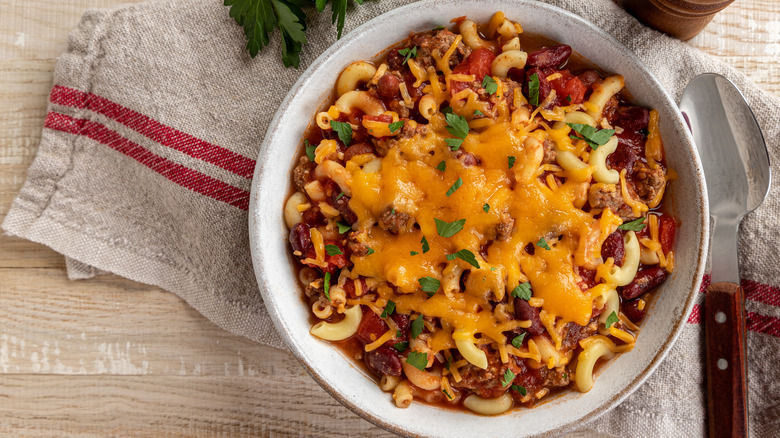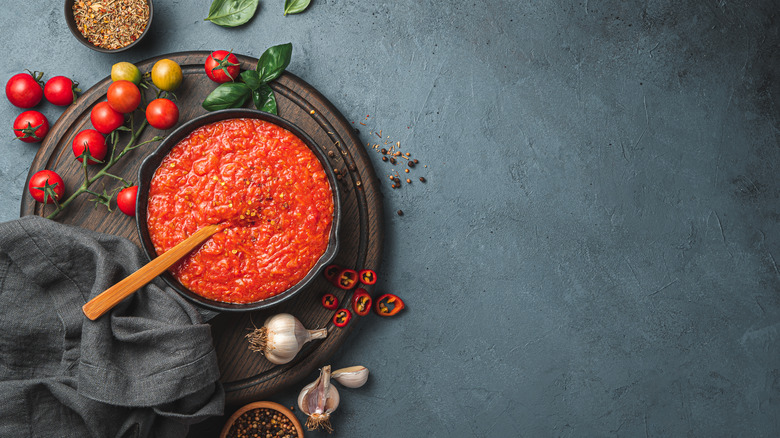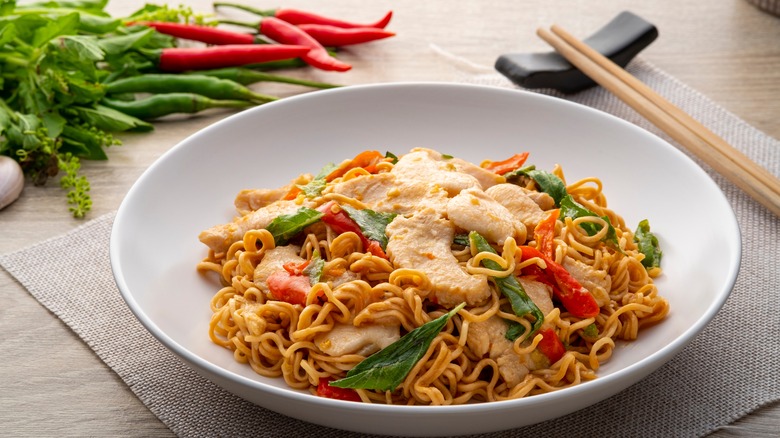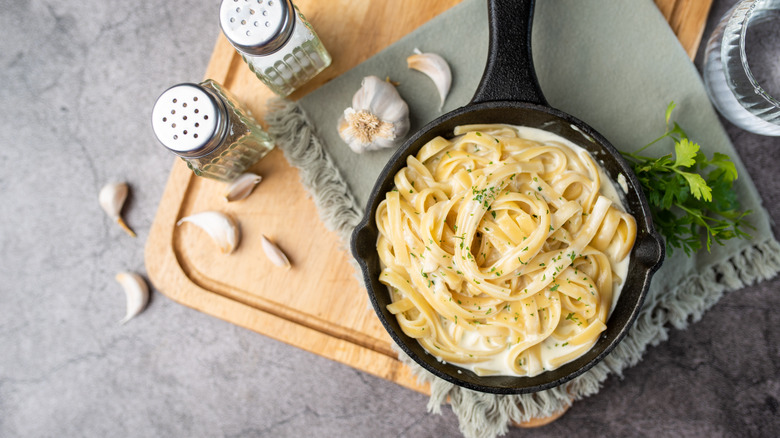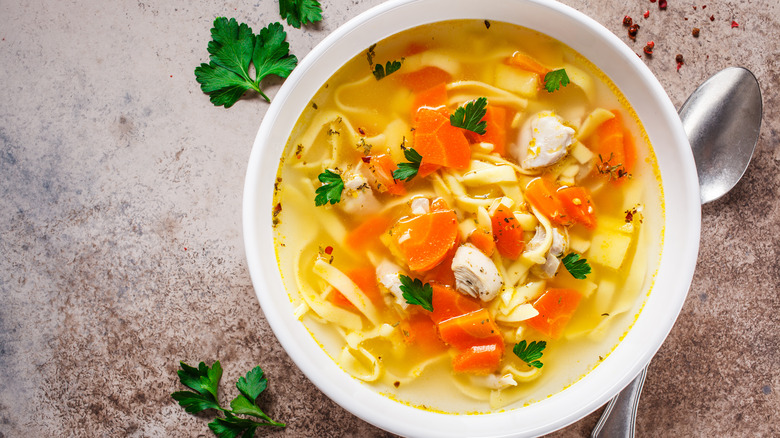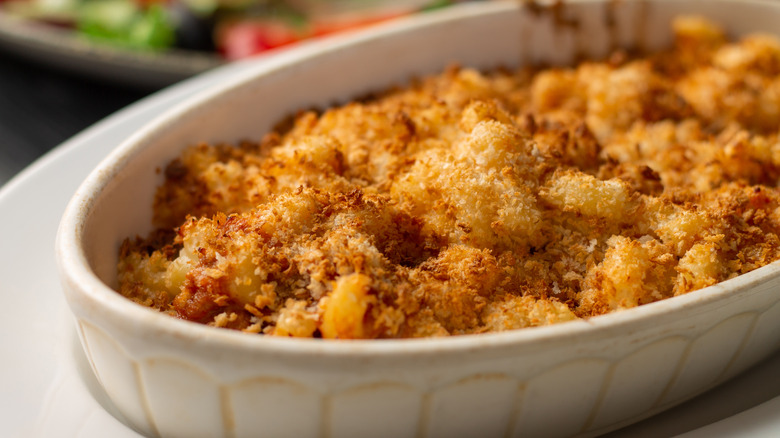13 Ways To Elevate A Simple Bowl Of Buttered Noodles
We may receive a commission on purchases made from links.
Even on the most hectic or gastronomically-uninspired nights, most of us can muster up the culinary chops to boil water and dump in some pasta. But sometimes the idea of digging into a bowl of plain noodles with nothing more than a pat of butter or a drizzle of olive oil just doesn't satisfy your cravings after a long day.
The good news is that with pasta in hand, you already have a fantastic blank canvas for dozens of delicious meal options. Whether you cooked up a pot of cute fork-able bowties or an elegant tangle of straw-like bucatini, with a few simple ingredient additions and minimal extra effort, you can transform your bowl of buttered noodles into a crave-worthy dinner.
This list of 14 easy ways to elevate a simple bowl of buttered noodles has all of the dinner inspiration you're looking for, from creamy cheese-topped masterpieces to protein-packed delights that will keep you well-satiated until morning. Put these noodle topping ideas to use next time you're staring into a bowl of plain pasta, and your stomach and taste buds will thank you.
1. Grate on some hard cheese
A generous dusting of hard cheese is an old standby pasta topper that has staying power for a reason. Choose a grainy cheese like Parmesan or pecorino romano, both of which will do double duty by adding both texture and a tangy, salty flavor to your dish. The concentrated, savory flavor of hard cheeses comes from the aging process.
In the case of Parmesan, for example, the cheese starts out as cow's milk that has had the fat removed, called "skimmed." Specific cheese-making bacteria are then added and the mixture is heated until it curdles. After being strained, the cheese curds are set into large round molds, called wheels, and brined in salt. As the cheese hangs out in its salt bath for a good three weeks, it takes on its signature saltiness. Then, the final step is to let the cheese wheels age for at least a year and often longer in a cool, dark environment. As the cheese ages, water evaporates and the flavor becomes increasingly concentrated and savory, making it the ideal topping for plain pasta.
When adding the grated cheese to your pasta, take a hint from celebrity chef Giada de Laurentiis, via Refinery29, who recommends adding it directly to the warm pasta in its cooking pot after draining. The residual heat slightly melts the cheese and adds a creamy texture. Plus, if you're adding sauce, it will adhere better to the noodles.
2. Add a dollop of pesto
Whether you grab it at the store, whizz it up at home in a food processor, or pound it the traditional way in a mortar and pestle, vibrant basil pesto is a wonder that turns plain noodles into a complete meal. While you can certainly find variations, the most traditional version of pesto is made with just a few simple ingredients. Basil traditionally makes up the bulk of the green pasta sauce and lends its anise-like, aromatic flavor and bright green color. Pesto is always made with fresh basil, not dried, and Genovese, or sweet basil, for the best flavor and color.
You'll also need fresh garlic. If you're making your own pesto, choose plump, white cloves that are blemish-free and have not sprouted. The other essential pesto ingredients are good-quality olive oil (preferably from Italy), pine nuts, and cheese. The exact type of cheese you use can vary, as some insist that Parmesan is the only way to make true pesto, and other chefs turn instead to the less-salty pecorino Romano (which is also more budget-friendly). Finally, to season your sauce to your liking, add a good pinch of kosher or sea salt.
The end result will be a brilliant green sauce that's savory, a bit sweet, and tasty enough to spoon right out of the bowl. Add a hefty dollop on top of your still-warm pasta, give it a good toss, and enjoy.
3. Spice it up
If you have a spice-loving palette, why not turn your plain noodles in a spicy direction? Adding your favorite hot sauce or a sprinkle of crushed hot pepper flakes is a simple way to amp up the flavor of your dinner.
And if the taste and experience of sweat-inducing dinner aren't enough to draw you in, consider that regularly eating spicy foods has been linked to some notable health benefits. In particular, according to a research paper published in BMJ, a long-term study on 500,000 Chinese adults found that those who ate spicy food nearly every day had a 14% lower risk of premature death, compared to their counterparts in the study who ate spicy food less than once a week.
Of course, not all hot sauce is created equal, and there's a lot of variety when it comes to degree of spice and additional flavors like garlic, onion, and vinegar. If you don't know where to start, consider picking up one of the most popular kinds of hot sauce in America, according to Instacart: Frank's RedHot or Cholulua, Both of these are great starting places for the spice curious. Remember to start slow and only add a little to your pasta to begin with as you can always add more!
4. Add an egg
A fried egg is a universally beloved protein topper to nearly any dish, from rice and toast to crispy breakfast potatoes. And chances are pretty good that if you have pasta in your pantry, you have an egg in the fridge.
If you need a reason to top your noodles with a sunny-side-up egg, consider that the egg is a nutritional powerhouse, per WebMD. It contains protein, fat, and essential vitamins and minerals your body needs to thrive. And if you fry it up just right, so the yolk remains a little jammy, it will act as a built-in sauce to coat your pasta in its luscious, savory goodness. This is a signature of the Italian pasta dish spaghetti carbonara, which is served with a whole egg yolk on top, ready to be mixed into the noodles to enrich the dish.
To keep your simple dinner as quick and easy as possible, cook your pasta and eggs at the same time. As soon as you add the pasta to the boiling water, crack the eggs into a hot skillet with a drizzle of olive oil or melted butter. This way, the fried egg will be hot and ready just as your noodles cook to al dente, s you can drain them, add the egg, and dig in.
5. Make mac and cheese
Macaroni and cheese is a childhood classic that makes just as much sense at the adult's table. The key to upgrading your bowl of pasta into a showstopping homemade mac and cheese is to choose the right kind of cheese. You'll want something that melts easily to coat your noodles. For maximum flavor, try a blend of several types, which will each add a unique flavor note.
For example, cheddar is a great melter that will add a sharp, bold flavor. Because cheddar can be so assertive, however, it's best to balance it out with something softer and even a little nutty or sweet tasting, such as Gruyere, Gouda, Muenster, or fontina. If you want to take things in a really rich and decadent direction, you could even add soft brie. Just be sure to remove the hard outer rind before adding brie to your mac and cheese.
6. Add rotisserie chicken
Adding protein to your pasta dinner is a great way to round out a meal of simple carbs. Protein will make the dish more filling and flavorful, plus it's a great way to sneak in some extra nutrients. If your local grocery store sells pre-cooked rotisserie chickens, you're in luck. By simply shredding or chopping a store-bought rotisserie chicken, you'll have a delicious and crowd-pleasing pasta topper that doesn't require any additional cooking.
Most rotisserie chickens are seasoned as they cook with a blend of herbs, such as thyme, oregano, and rosemary. These all enrich the meat with an aromatic, savory flavor that your pasta will just soak right up.
While you can simply slice the meat off the bones and chop it up into bite-sized pieces to toss with your noodles, shredding your chicken is a great way to break down the meat so it mixes evenly in the pasta. The best way to shred a rotisserie chicken is to do so as soon as you bring the bird home from the store, while it's still warm. If you're pulling your chicken from the fridge, warm it in the microwave or on the stove with a splash of broth, wine, or water until it's warm (but not too hot to touch), and softened. You can either use your hands to shred it, or put it in a deep bowl and use your hand mixer to do it quickly and easily.
7. Go green
Adding your favorite cooked green vegetable or a mix of several colorful veggies is a great way to make your buttered noodles both healthier and feel a little fancier. When it comes to choosing a vegetable to add to your pasta, the options are pretty endless. But if you want to streamline the cooking process and limit the number of dirty dishes, consider adding a quick-cooking green veggie that you can cook right in the boiling water with your pasta.
Blanching is the process of quickly submerging chopped vegetables into boiling salted water until they turn bright in color and crisp-tender. Then, you immediately drain the water to stop the cooking process. If you time things well, you can simply add your prepped vegetables to the pasta cooking water during the last few minutes of cooking, then drain the entire pot and you'll have perfectly cooked pasta and veggies ready at the same time. The best choices for quick-cooking vegetables to blanch with your noodles include broccoli, green beans, asparagus, peas, cauliflower, and carrots.
8. Go Tex-Mex
If you love Tex-Mex burritos and tacos, why not apply those same beloved flavors to pasta? The classic flavors and ingredients include dried ground cumin, ground beef, black beans, and grated cheddar or Monterey jack cheese. Notably, Tex-Mex cuisine also uses more wheat flour than traditional Mexican food, which means that pasta will fit right into the mix.
One easy way to top your pasta and take things in a Tex-Mex direction is to quickly sauté ground beef that's seasoned with the familiar flavors of the regional cuisine. This recipe for ground beef tacos offers a helpful guide for cooking ground beef with onions for crunch, and seasoning the meat with the right ratio of chili powder and Mexican seasoning mix. If you want to round out your Tex-Mex pasta with a dollop of something creamy and fresh, take a note from tacos and make a quick guacamole to complete the dish.
9. Add a doctored-up tomato sauce
Your very first idea when thinking about how to dress up plain noodles might be a timeless classic: tomato sauce. And if you have a jar of store-bought sauce on hand, you're well on your way to a tasty dinner. But if you have a few extra minutes — maybe while the pasta simmers — a bit of doctoring-up can take your favorite jarred sauce to a new level.
For example, you could simply heat the sauce on the stove and stir in a mix of dried herbs or a pre-made seasoning blend. Many jarred sauces are already seasoned with Italian herbs, so to stay in that lane but bring things up a notch, add dried basil, oregano, or garlic or onion powder. You could also toss a parmesan cheese rind into the pot, which will enrich the sauce with a creamy, cheesy flavor as it simmers. Speaking of creaminess, adding a splash of cream or even a scoop of cream cheese will thicken up your marinara and turn it into a decadent meal.
Famous Italian chef and cookbook author Marcella Hazan is known for her signature (and incredibly simple) tomato sauce from the book Essentials of Classic Italian Cooking. She makes her unforgettable sauce by simmering canned tomatoes with half of an onion and a stick of butter. The result is slightly sweet and rich, as the butter emulsifies into the sauce for a lovely silky texture.
10. Add a soy-based sauce
If you're cooking up a batch of rice, udon, or soba noodles, opt for an Asian-inspired sauce. You can harness the flavors of your favorite Chinese, Japanese, Thai, or Korean noodle dishes with a few ingredients that are likely already in your fridge. For example, make vibrant and savory ginger-soy noodles with fresh ginger, shallots, and soy sauce. You can amp up the flavor further by adding garlic and a drizzle of sesame oil.
Or, if you prefer a thicker sauce to really coat your noodles, try adding tahini or peanut butter to a soy sauce-based dressing. The creamy, nutty pastes will also temper any heat, so this is another great opportunity to add a dash of hot sauce, such as Sriracha or sambal oelek. For crunch on top, pair tahini noodles with toasted sesame seeds or peanut butter noodles with crushed, roasted and salted peanuts.
11. Make a quick, creamy alfredo sauce
Alfredo sauce adds a delicious blanket of decadence and coziness to your pasta. And the good news is that though it tastes gourmet, a basic alfredo is actually not complicated to make with just a few ingredients.
For the simplest sauce, you'll only need unsalted butter, grated Parmesan cheese, salt, and pepper. The key is to keep some of the starchy water that you cooked your pasta in to add to the sauce; this helps loosen it up so it can fully coat the noodles. Be sure to make your alfredo sauce in a large, high-sided skillet with plenty of room for tossing so you can give everything a thorough mix.
You may want to add some protein to your pasta with alfredo sauce and chicken is a classic addition. You could use chopped or shredded rotisserie chicken here, or simply grill or roast up a few chicken breasts or thighs to slice and arrange on top of the dish. If you prefer seafood, shrimp makes a delightful and subtly sweet topping. For vegetarians, you can't go wrong with grilled or seared tofu tossed in alfredo.
12. Turn it into a cozy soup
If it's a chilly night and you're looking for a meal to cozy up with, a bowl of noodles can quickly be transformed into an entirely different dish, such as a warm bowl of soup, with a few simple additions. And while the classic chicken noodle soup is always an option, noodles will work in more than just broth-based dishes. For example, stir orzo or bowties into a creamy puree of butternut squash or sweet potato soup. Or, go with the familiar pairing of pasta and tomato by adding noodles to canned or homemade tomato soup. If you'd rather go with store-bought soup, anything that doesn't already have noodles, rice, or potatoes in it will benefit from the addition.
One thing to keep in mind when making soup with noodles is the size and shape of your pasta. Because you'll be eating the dish with a spoon, it's easiest to stick with a short-cut noodle, such as orzo, shells, or ziti. However, you can turn longer pasta, such as angel hair or spaghetti, into short pieces by simply breaking up the strands before cooking them.
13. Add a crispy topping
Everyone loves a crispy crust on a casserole, and the mouthwatering effect is easy to achieve by baking your pasta with a special topping. First, make sure that your noodles are in an oven-friendly baking dish. Then, sauce them up however you like, such as with melty cheeses, jarred or homemade tomato sauce, or alfredo. Then add the final topping — you want something that will crisp up and turn golden and crunchy in the oven, such as breadcrumbs, panko, crushed Ritz crackers or saltines, or even nuts. For added flavor, mix in some shredded or grated cheese.
Panko are Japanese breadcrumbs that may be preferable to Italian breadcrumbs if your goal is to optimize crunch. Panko are only made with white bread and absorb less oil than Italian breadcrumbs, which gives them a lighter, airier texture similar to what you get from deep-frying.
After you've topped your pasta with your desired crunch factor, stick the baking dish under your oven broiler for a few minutes. It's important to keep a very close eye on the pasta when it's under the broiler, as those heating elements can get very hot, very fast, and may cook unevenly. Rotate the dish if you see any hot spots browning too quickly.
